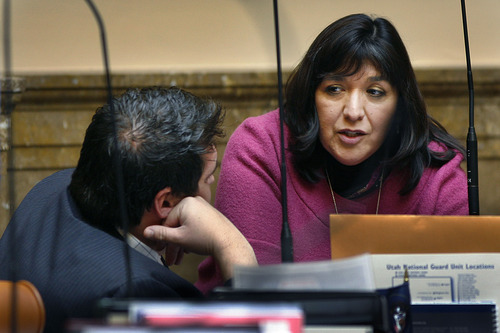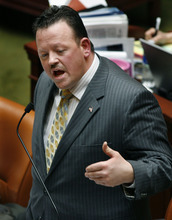This is an archived article that was published on sltrib.com in 2011, and information in the article may be outdated. It is provided only for personal research purposes and may not be reprinted.
New score cards for the 2011 Legislature by both conservative and liberal groups agree that the Utah Capitol has a definite rightward tilt — leaning maybe even more than a famous tower in Pisa.
In fact, on a scale of 0 to 100, where 100 is the most conservative possible and 50 is the political center, legislators scored a median of 73 this year — or well to the political right. Last year, they scored a somewhat less extreme 67.
"Utahns themselves are well to the right, so it's typical," said Senate Majority Leader Scott Jenkins, R-Plain City. "When you talk about the Republican Party in the majority, yeah, it's in the 75 percent range" of leaning to the right. He adds that GOP delegates tend to be extra conservative "and are the most active, so they help to elect people who are more conservative."
Republican lawmakers tend to lean further to the right than Democrats lean to the left. The 80 Republicans in the Legislature scored a median of 75, or 25 points to the right of center. The far-outnumbered 24 Democrats in the Legislature scored a median of 32 — or 18 points to the left.
Some subgroups were more extreme. Senate Republicans were furthest to the right with a median of 81 (31 points from center), while House Democrats were furthest to the left with a median of 25 (25 points from center).
The Salt Lake Tribune gathered annual ratings of legislators by five special-interest groups, and then standardized and averaged scores. That includes three conservative groups: the Utah Taxpayers Association, GrassRoots and Parents for Choice in Education. It also included two liberal groups, the Sierra Club and the Utah Education Association teachers' union.
Each group ranks lawmakers by how often they vote "correctly" in their view on bills important to them. While the groups differ greatly on issues, they tend to agree on how conservative or liberal individual members are.
Whether members scored to the right, left or center, they say it reflects voters in their districts.
The lawmaker furthest to the right is Rep. Carl Wimmer, R-Herriman, with an average score of 90.3 out of 100 (40.3 points from the political center).
"It's interesting it came out that way," says the founder of the conservative Patrick Henry Caucus and a potential candidate for Congress. "I vote on principle, and I never vote trying to be the most conservative or libertarian or anything else."
But, he adds, "it doesn't surprise me. I vote based on certain conservative principles of limited government and individual liberty." He said, "No doubt my district is the most conservative in Salt Lake County. ... I represent their views quite well."
He made headlines this year by passing bills to restrict abortions, a resolution calling for a balanced budget amendment and a bill naming the Browning-designed M1911 handgun as the official state firearm — making Utah the first state with such a symbol.
On the other end of the spectrum, Rep. Rebecca Chavez-Houck, D-Salt Lake City, was the most liberal in the Legislature, with an average score of 16 (34 points from the political center).
She says she deliberates on bills carefully, and "I may do that with a progressive eye, but I don't necessarily look to see if legislation fits into a 'liberal' box. I look to see if legislation is constitutional, if it is in the best interest of the community at large, and if it makes common sense."
She adds that her votes reflect "the majority voice of House District 24, which is a pretty liberal district" covering the central city and Avenues neighborhoods of the capital.
Being outnumbered by conservatives and Republicans has allowed her to pass only five bills in four terms, but, she said, "I am an effective spokeswoman for my constituents and their views."
The person closest to the political center, according to the scores, was Rep. Susan Duckworth, D-Magna. She scored 50.2, almost dead center.
"That's a good thing," she said. "My district was seen as a Democratic stronghold, but has since grown to include a lot of right-wing voters and independents. I'm fairly moderate, and feel I represent the district."
While most Republicans tilt right and Democrats lean left, some exceptions occur.
Rep. Neal Hendrickson, D-West Valley City, was the most conservative Democrat with a score of 51 — but essentially at the center of the political spectrum.
"That's the way my district is, too," he said. While moderate stands may be popular with his district, he said, it isn't always popular with fellow House Democrats. "I get overlooked for some committees because I am too conservative," he said.
Rep. Rebecca Edwards, R-North Salt Lake, is the most left-leaning Republican with a score of 42. It was further to the left than four Democrats.
2011 Utah Legislature rated
For a PDF, see a chart detailing each lawmaker at http://bit.ly/iaQAyF





